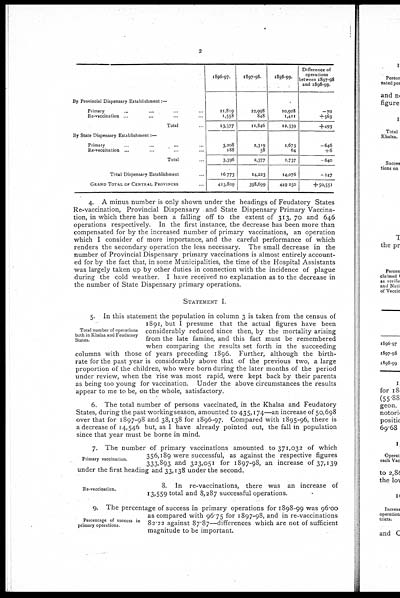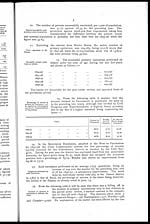Medicine - Vaccination > 1868-1929 - Report on the vaccine operations in the Central Provinces > Vaccine operations Central Provinces 1886-1899 > 1898-1899 - Triennial report on vaccination in the Central Provinces for the year 1898-99
(451) Page 2
Download files
Individual page:
Thumbnail gallery: Grid view | List view

2
|
1896-97. |
1897-98. |
1898-99. |
Difference of |
|
|
By Provincial Dispensary Establishment :— |
||||
|
Primary ... ... ... ... |
11,819 |
10,998 |
10,928 |
—70 |
|
Re-vaccination ... ... ... ... |
1,558 |
848 |
1,411 |
+563 |
|
Total ... |
13,377 |
11,846 |
12,339 |
+493 |
|
By State Dispensary Establishment:— |
||||
|
Primary ... ... ... ... |
3,208 |
2,319 |
1,673 |
—646 |
|
Re-vaccination ... ... ... ... |
188 |
58 |
64 |
+6 |
|
Total ... |
3,396 |
2,377 |
1,737 |
—640 |
|
Total Dispensary Establishment ... |
16,773 |
14,223 |
14,076 |
—147 |
|
GRAND TOTAL OF CENTRAL PROVINCES ... |
413,809 |
398,699 |
449,250 |
+ 50,551 |
4. A minus number is only shown under the headings of Feudatory States
Re-vaccination, Provincial Dispensary and State Dispensary Primary Vaccina-
tion, in which there has been a falling off to the extent of 313, 70 and 646
operations respectively. In the first instance, the decrease has been more than
compensated for by the increased number of primary vaccinations, an operation
which I consider of more importance, and the careful performance of which
renders the secondary operation the less necessary. The small decrease in the
number of Provincial Dispensary primary vaccinations is almost entirely account-
ed for by the fact that, in some Municipalities, the time of the Hospital Assistants
was largely taken up by other duties in connection with the incidence of plague
during the cold weather. I have received no explanation as to the decrease in
the number of State Dispensary primary operations.
STATEMENT I.
Total number of operations
both in Khalsa and Feudatory
States.
5. In this statement the population in column 3 is taken from the census of
1891, but I presume that the actual figures have been
considerably reduced since then, by the mortality arising
from the late famine, and this fact must be remembered
when comparing the results set forth in the succeeding
columns with those of years preceding 1896. Further, although the birth-
rate for the past year is considerably above that of the previous two, a large
proportion of the children, who were born during the later months of the period
under review, when the rise was most rapid, were kept back by their parents
as being too young for vaccination. Under the above circumstances the results
appear to me to be, on the whole, satisfactory.
6. The total number of persons vaccinated, in the Khalsa and Feudatory
States, during the past working season, amounted to 435,174—an increase of 50,698
over that for 1897-98 and 38,138 for 1896-97. Compared with 1895-96, there is
a decrease of 14,546 but, as I have already pointed out, the fall in population
since that year must be borne in mind.
Primary vaccination.
7. The number of primary vaccinations amounted to 371,032 of which
356,189 were successful, as against the respective figures
333,893 and 323,051 for 1897-98, an increase of 37,139
under the first heading and 33,138 under the second.
Re-vaccination.
8. In re-vaccinations, there was an increase of
13,559 total and 8,287 successful operations.
Percentage of success in
primary operations
9. The percentage of success in primary operations for 1898-99 was 96.00
as compared with 96.75 for 1897-98, and in re-vaccinations
82.22 against 87.87—differences which are not of sufficient
magnitude to be important.
Set display mode to: Large image | Zoom image | Transcription
Images and transcriptions on this page, including medium image downloads, may be used under the Creative Commons Attribution 4.0 International Licence unless otherwise stated. ![]()
| Permanent URL | https://digital.nls.uk/91513465 |
|---|
| Attribution and copyright: |
|
|---|



![[Page 1]](https://deriv.nls.uk/dcn4/9151/91513464.4.jpg)
